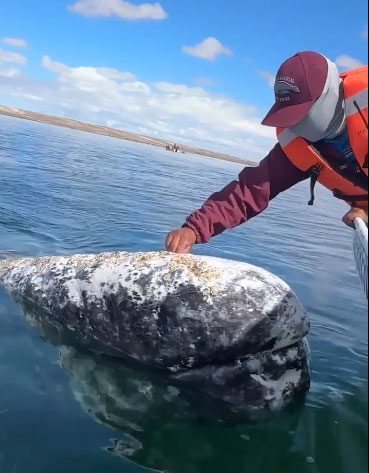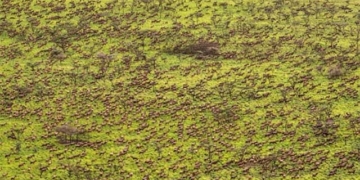Gray whales learn to approach tourist boats to ask humans to remove the itching barnacles from their skin.
A gray whale swims close to the boat to ask humans for help in removing barnacles. (Video: Guardian).
The footage capturing the behavior of the gray whale was recorded by tourist boat captain Paco Jimenez Franco in the Ojo de Liebre lagoon off the coast of Baja California, Mexico. In the video, the whale swims close to the side of the boat and tries to float on the surface while Franco continuously removes barnacles from its head.
Whale barnacles are pale, crab-like creatures that attach to the whale’s skin, feeding on algae that grow on their bodies or consuming dead skin and necrotic tissue around injuries. However, they also cause irritation to the whales.
“I believe gray whales have a love-hate relationship with barnacles,” said Mark Carwardine, a British zoologist. “They have very sensitive skin. Thousands of tiny barnacles clinging to or crawling on their skin with sharp claws must surely be uncomfortable for them.”
Franco first removed a barnacle from the whale’s head when it approached close enough. After he removed the first barnacle, the whale swam closer for more assistance. The gray whale repeatedly returned to ask Franco to remove the parasites.

Paco Jimenez Franco removes the barnacle from the whale’s head for the first time when it came close enough.
Like many large whale species that move relatively slowly, including humpback whales and gray whales, the gray whale, which can grow up to 15 meters long, is particularly vulnerable to parasites. They also host barnacles on their bodies while foraging for crustaceans in muddy seafloor habitats.
Gray whales off the coast of Baja California are quite bold around boats, despite having been heavily hunted in the 20th century. Carwardine could not determine whether the whale’s approach to humans for barnacle removal constituted a new behavior in whales. “The whale seems unfazed by humans removing barnacles, even though you need to remove hundreds to make a difference,” the researcher noted.
Since barnacles feed on dead skin and necrotic tissue from the whale, according to Carwardine, rather than being classified as parasites, they fall into the category of symbionts, meaning both species benefit from the interaction. Given that gray whales can live for at least 80 years, they may have adapted to take advantage of interactions with humans.


















































